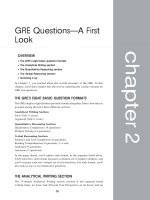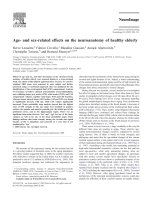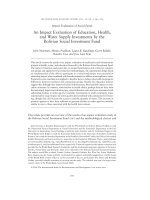Playing, Laughing and Learning with Children on the Autism Spectrum - part 6 ppt
Bạn đang xem bản rút gọn của tài liệu. Xem và tải ngay bản đầy đủ của tài liệu tại đây (96.19 KB, 29 trang )
The need for structure
As with all the play activities in this book, find a way to communi
-
cate to your child (with picture prompts) – first that he will be
going outside and second, what specific activity he will be playing
with. Don’t forget to take photos of your child playing a particular
game so that they can be used in the future as a picture prompt. If
your garden is too small or unsuitable for some of the activities, try
friends/relatives, gardens, or go to the park early, before it gets
busy.
Some children will need a reward/reinforcer for attempting a
particular activity. Try the activities your child will spontaneously
engage in, for example, the trampoline first and then use this as a
reward for something more challenging. Don’t forget to commu-
nicate to your child (with a picture prompt) that this preferred
activity will follow the one that is not as attractive.
Getting started – games and activities
As well as the following ideas, don’t forget to check Chapters 8
and 10 for further ideas on physical activities and water play that can
be used outside.
Pavement chalking
J Draw a circle on the floor and practice taking turns
jumping into it – try the rhymes suggested in Chapter 8
(‘Physical Play’) for jumping in and out of a hoop.
J Try the Pavement Chalker by Fisher Price (see
references at the end of the book). This is a wheel on a handle,
with a clasp to hold the chalk. The child pushes it along the
ground like a line marker used to mark out courts etc. The
activity itself is easy and rewarding and you can add tasks such
Outdoor Play 145
as joining up two dots with a straight line or making wavy,
zig-zag lines etc.
J Pavement chalking provides lots of opportunities for
practising early literacy skills – see Chapter 14 (‘Books and
Reading’) for more ideas.
J Chalk different shapes onto the ground and encourage
your child to jump onto the requested shape after saying
‘ready…steady…go’. Start with only one shape, then add new
ones, one at a time. Vary this with activities such as requesting
your child to ‘put the bean bag on the square/circle’ etc. To
add further receptive language skills, move on to presenting a
choice, for example, bean bag, teddy, brick and chalk further
shapes in different sizes and colours. You might then ask your
child to ‘Put teddy on the small circle’ or ‘Put bean bag on the
yellow triangle’. Continue to use ‘ready…steady…go’ and
rewards where necessary (verbal or otherwise). Remember
some children with autism really don’t like over enthusiastic
shrill voices. Be aware if this is the case (he may actually see
this as a reason not to co-operate). Try using bubbles, tickles,
treats instead – see Chapters 2 and 3 for more ideas on positive
reinforcement.
J As well as chalk, you can also draw on the ground with
sand in a plastic bottle with a hole in, or with water in a squirty
plastic bottle (those with a sports sipper cap are ideal).
Throwing balls at targets
J Fill a large plastic bowl/bucket or storage box with
water (add coloured food dye for variety) and take turns
throwing a ball into it. Try the following rhyme:
Can Sally see the water in the box over there?
Where is the water, Sally? Sally point where.
146 Playing, Laughing and Learning with Children on the Autism Spectrum
Sally hold the ball and Sally throw now
Splish splash splosh – look, Sally. Wow!
For your turn just change the words in the third line to,
‘Mummy hold the ball and Mummy throw now.’ For more
rhymes see Chapter 8 (‘Physical Activities’).
J As well as throwing the ball into water try throwing it at
a bell or wind chimes, or throwing it through a basketball net.
(Fix this where it is achievable for your child.)
Sand play
If your garden is too small for a sand pit, or a pit is simply too over-
whelming for your child, try filling a plastic storage crate with
sand. (Remember to always use play sand in sand pits/boxes
rather than ordinary builders’ sand.) Wet sand might feel too
uncomfortable so try dry sand at first and have a towel ready for
him to wipe his hands on. Provide him with one or two containers,
a small spade and a funnel. He might like to watch the sand flow
from the funnel into an empty plastic drinks bottle, or try a sand
toy, whereby the sand drives a wheel round. Only put enough
articles for one activity at a time in with him. Your child might get
a little lost in himself watching the sand run through his fingers.
Allow him some time to do this then gently refocus him back to
joint play.
J Build a series of sand castles. Then, after a count of three,
let him jump on them one at a time.
J Provide a length of broom handle (with the end sanded
smooth) for your child to draw shapes in the sand. You could
create a greater surface area for this by putting a small amount
of sand onto a large piece of wood or a stone slab. Try a talking
commentary about what he is doing, for example, (Alex draws
Outdoor Play 147
a random shape which looks like a letter), ‘What will Alex
draw? C, C, C, C. Alex draws a letter C – C for car and cat, Alex
draws a letter C.’ Try to make your child aware that what he is
doing has an effect on what you say. Keep the commentary
simple, not too loud and at first only comment on your child’s
spontaneous actions without directing them.
J If your child likes looking at road works, cranes, diggers
etc., the sand pit/box is a great way to play realistically with
them. Alternatively, for even more realism you could fill a box
with clean dry potting compost which might have a more
appealing texture than hard gritty sand.
Messy art
Outdoors is a particularly good place to work on a large scale –
children with fine motor skill delays get less frustrated making big
shapes than they do trying for example, to manipulate a paint
brush on a small-scale drawing. Outside is also a great place to
experiment with colour and texture without worrying about mess.
All children can be particularly good at making a mess so take the
paints outside and really enjoy it!
Check out Chapter 12 (‘Being Creative’) for art activities that
can be done outside. In addition, try the following:
J Tape a large piece of lining paper (or wallpaper, reverse
side up) to the side of a wall/shed/garage. With a decorator’s
paint brush let your child paint big shapes/long wavy lines or
random marks. You might try drawing a simple shape like a
cross at the opposite end of the paper to see if he will copy you.
J You could also allow him to dip a toy car into paint
(water-based poster paint for easy clean ups!) and run it along
the paper. Try doing this at your end of the paper (with a
second car). Alternate making the car go fast and slow, straight
148 Playing, Laughing and Learning with Children on the Autism Spectrum
and wavy (make appropriate noises to indicate what you are
doing). See if your child will imitate what you are doing with
his car.
J A decorator’s small roller brush can also be a highly
satisfying way of putting paint onto paper for a child who is
having difficulty co-ordinating a brush or applying enough
pressure.
J Experiment with different ways of getting the paint on
the paper – dipping sponges in a tray of paint; flicking paint
with fingers or brushes; hand, foot, even nose and tummy
prints! Have a bowl of water, a wash cloth and a towel handy!
On a very hot day have a painting session first, followed by a
play in the paddling pool to make cleaning up less of a chore.
J When you have a day at the beach, don’t forget to collect
pebbles and shells to use in art activities and try the following.
Roll out a thick layer of air-drying clay onto a piece of board
or a plastic tray (smear a thin layer of petroleum jelly onto it
first to help it release when it is dried). On a separate tray have
your collection of beach treasure, perhaps with some
additional pieces in it, such as glass nuggets, bits of twig, string
etc. Take turns at pushing the objects into the clay and then
leave the clay in the sun to dry. (Taking turns can be
problematic for children with autism but is a vital skill to
pursue, check Chapter 7 for ways to tackle turn-taking.) When
the plaque is dry, if any items feel loose, take them out and glue
them back into the impression they have made, with a dab of
PVA or other suitable adhesive. Display the plaque where your
child can see it, perhaps alongside his beach photos. Talking
about past experiences using physical items such as shells,
photos etc. helps your child to recall specific experiences and
interpret their meaning (rather than just recalling a collection
of sensory experiences and negative emotions). It also helps
him understand a collection of words appropriate to a day at
Outdoor Play 149
the seaside. This activity can also be used after a day walking in
the woods (collect leaves, pebbles, twigs, seed heads, conkers,
acorns etc.).
J Run a length of lining paper along the ground, weighted
down each side with a large stone. Drop a medium-size rubber
ball into a bowl of poster paint and take turns (see Chapter 7)
rolling it to each other along the paper to make a coloured line.
If your child is enjoying the activity but doesn’t like the
sensation of touching a ball covered in paint, let him wear
mittens or plastic gloves (rolling a ball whilst wearing gloves is
a good sensory exercise in itself).
Pet shops are good sources of rubber balls for this activity;
many sell a variety with different textured surfaces. Even those
with a bell inside help to capture attention.
Try the following rhyme:
Ball in the paint, ball on the paper, roll roll roll to you
Stop stop the rolling red ball, can you do it too?
Ball in the paint, ball on the paper, roll roll roll to me
What have we made ?…a wiggly red line
Look, Tom – can you see?
J Try attaching a number of lengths of string (about 20) to
a short section of broom handle with a piece of tape (like a
small mop). Dip the ends into watered down poster paint and
let your child mop the colour onto the pavement.
Alternatively, use a less watery mix and let him drag the colour
up and down a length of paper.
Balance and co-ordination games
Stepping stones
J Stepping stones can be anything from house bricks,
carpet tiles, to pieces of wood, or circles chalked on the patio.
150 Playing, Laughing and Learning with Children on the Autism Spectrum
Judge how far apart and how high they should be according to
your child’s ability. To make it easier to differentiate the
stepping stones from the ground, paint or chalk a bright
colour onto them. As always, clear away any distractions so
that all your child has to focus on are the stepping stones
themselves.
J To add extra interest and learning potential, stick a
picture onto each stone and ask your child to step on the
picture of the…house, flower, cat. You might add to the
game’s potential by saying, ‘Step on something that we live in’
etc. Also try, number, letter and word stepping-stone games.
J Try covering half a dozen cork tiles with various textures
– fur, silver foil, sandpaper, soft fabric, corrugated card, etc.
Start by labelling them as your child steps onto them (with
bare feet) – furry, smooth, rough, soft, bumpy etc. Keep the
same label consistent. You might then play a
‘ready…steady…go’ game.
J Using the above set of tiles, make an identical set and
play a matching game, for example, your child stands on the
soft square and you say, ‘Jump on something that feels the
same’ or ‘Jump on something that feels different’. Tailor your
language to your child’s language level, i.e. you might just say
‘same’ or ‘different’.
Balance beams
J A balance beam doesn’t necessarily have to be off the
ground – to start with, try joining two stepping stones with a
length of ribbon, fabric, washing line – anything that creates a
line he can follow between two points. You can then move on
to balancing a piece of wood over two bricks and walking
Outdoor Play 151
along it, stepping over it, crawling under it. Try the following
rhyme:
Follow me, follow me, where will Mummy go?
Over here, over there, stepping to and fro
Wibble wobble, wibble wobble, do you think I’ll fall?
Wibble wobble, wibble wobble…no not at all!
Don’t forget to pretend to wobble! When it’s your child’s turn,
just replace ‘Mummy’ with his name.
Outdoor adult role-play
Once they learn to imitate action, children with autism can often
mimic adult actions in great detail. Copying actual everyday activ-
ities is something that has real meaning, is not ambiguous, does
not require imaginative leaps and can be a fun and rewarding
thing to do in its own right. With my own son, much of his spon-
taneous play involves toy versions of adult equipment –
lawnmowers, cameras, mops/buckets etc. Needing props is part
and parcel of this play and he struggles to improvise with imagi-
nary props. Even now, if he pours pretend tea his teapot must
contain real water. To pretend that he is pouring is simply not
enjoyable enough to do. Playing outdoors offers lots of scope to
do real activities, for example:
J Filling plant pots with soil and planting bulbs.
J Watering plants.
J Washing tables/chairs.
J Washing the car/bicycles.
J Washing the windows.
J Sweeping.
152 Playing, Laughing and Learning with Children on the Autism Spectrum
J Provide equipment for your child to use and be aware
that he might want his own version of everything you use. So if
you put detergent in your water, provide him with his own
bottle (for economy, use a nearly empty bottle filled up with
water). Don’t forget to keep up a simple commentary about
what you are doing whilst you do it. You might try a singing
commentary as detailed in Chapter 6 (‘Music’).
Picnics
J Eating outdoors is a fun and exciting activity for all
children. Children with autism, however, require some extra
preparation to enjoy a picnic outside. Before embarking on a
full-scale picnic, try to label the activity of eating outside a
‘picnic’ even if it is only eating a biscuit, sitting on a cushion in
the garden. Non-autistic children have usually worked out the
meaning of ‘picnic’ before they actually have one themselves,
but again children with autism usually need to experience an
event before they can understand its meaning. As well as
giving it a verbal label, also use a picture card to represent
‘picnic’. You might want to make two – one for
teddies’/dollies’ picnic and one for Tom’s picnic (use your
child’s name).
J Start by introducing a pretend picnic game in the garden
(communicating first that you are going to play ‘teddy bears’
picnic’). Gather together a few simple elements: a small
blanket, two bears, plates, cups, round cardboard circles for
cakes and a teapot. Even though I often emphasise the
importance of realism, try to resist the temptation to use real
food at first, as this can be too distracting and makes the
significance of the other elements much less meaningful. Your
child might be very likely to collect his cake, walk away and
leave you to play picnics on your own! Only attempt five
minutes concentration at first, during which you encourage
Outdoor Play 153
him to imitate feeding the bears, making appropriate sounds
etc. Use a simple script that can be repeated each time you play,
for example:
‘Today Fluffy and Blackie bear are having a picnic. Fluffy
wants a biscuit. Can Joshua give him one? Now Blackie wants
a cup of tea? What a lovely picnic – was that good bears?’
Once your child is engaging in the play you might want to
introduce a plate and biscuit for him and you, but make sure
the bears are fed their pretend food too!
J From this you could try moving onto a real picnic. (If
sensory overload outside is too much, try a picnic in the living
room first.) You might feel a ‘picnic’ is simply another name for
eating a meal. However, the novelty of occasionally eating in
this way helps your child:
•
discover an activity that is enjoyable that eventually
might include being away from the house and being
with others
•
experience an activity that he can relate to in stories and
later on in discussions at school
•
experience pretend play with toys that has an attractive
and motivating element (food)
•
take part in a situation where the potential for
interaction is enhanced by engaging in a novel and
pleasant experience
•
enjoy an activity that siblings can get involved with.
Once again be aware of your own child’s individual needs. Don’t
spring a collection of new foods on him hoping that the novelty of
the situation means he’ll eat differently – he probably won’t and
will get distressed. Don’t overload him with language; keep sen
-
154 Playing, Laughing and Learning with Children on the Autism Spectrum
tences short and don’t ask too many questions that you’ll end up
answering yourself. Say a sentence, for example, ‘This is a big red
tomato’ and a little later repeat it. If your child is verbal you might
want to test whether he has understood by asking, ‘Is this a big
blue tomato?’
Remember, if you try a picnic away from home, you might
come against problems if you go along a familiar walk. On a
regular route – perhaps where you feed ducks or go on the swings
– your child may find it difficult to deviate from his usual activity.
For this situation, find a novel location that he can come to associ
-
ate with having a picnic, and then work on building in flexibility.
Big outdoor play equipment
It’s common sense to visit parks at quiet times, to avoid as many
stresses as possible. On a busy day you might conclude that your
child dislikes this type of activity when all he really dislikes is the
bombardment of noise and activity from other children. Take
plenty of photos to use as picture prompts and to talk about later;
also take something to wipe down slides and swings in case they
are wet. (It’s impossible to explain to a child with autism that he
can’t go on the swing because it’s wet!) If your child is prone to
knocks and bumps, pack some plasters or a bandage and keep his
arms and legs covered.
Swings
Be aware of where your child is in terms of balance and
co-ordination; just because his younger brother can use a plain
swing doesn’t mean your older child with autism no longer needs
the bucket style. Like trampolining, swinging can provide a
motion that is highly pleasant and can be used as a way to increase
Outdoor Play 155
interaction. Likewise, to some children this type of motion can be
distressing and uncomfortable – take your child’s lead.
J If your child appears to enjoy the swing, you have a great
tool to help you engage his attention. First, if you stand in front
of him, he will find it hard to avoid eye contact and the
swinging provides natural rhythm for you to use as part of
your interaction. This is a good activity to use rhyme (but for
this rhyme only if your child is in a bucket swing and has a
hand free!).
Swinging, swinging, Jacob in the sky
Swinging, swinging, Jacob flying high
Touch Mummy’s hands with your flying knees
Touch Mummy’s hands with your flying toes
Clap Mummy’s hands with your flying hands
Pat your head and touch your nose.
or
(To the tune of ‘London Bridge is falling down’)
Katy Smith is swinging high, swinging high, swinging
high
Katy Smith is swinging high, swinging on a swing
Katy’s going to touch the sky, touch the sky, touch the
sky
Katy’s going to touch the sky, swinging on a swing.
If you have a swing at home and your child has outgrown the
bucket seat but is too unsteady for a regular seat, first shop around
– bucket style seats vary in size. If all else fails, ask a local joiner to
put one together for you – a simple square shape made from slats.
Always make sure that your existing rope is strong enough to take
your child’s weight.
156 Playing, Laughing and Learning with Children on the Autism Spectrum
Slides
Slides can be easy for children with autism to co-ordinate (they
may need extra supervision on the steps) and can provide a
pleasant sensation.
J ‘Ready, steady…go’ games are natural to use on slides.
Also try to encourage your child to repeat ‘up’ and ‘down’ as
appropriate.
J For more able children, you can try some real challenges.
Take some picture cards along with you and while your child
is at the top of the slide ask him to tell you what the picture is
before sliding down again. My own son finds this game very
enjoyable – the tension of having to wait and the pleasure of
getting something right are heightened in this situation.
J During all these activities, encourage your child to ask
for ‘more’ or ‘again’ rather than just taking your hand back to
the activity. Ask, ‘More?’ Give your child plenty of time to
respond and accept any effort your child makes with praise
and reward – ‘Yes, Jack said more. OK then’. For a nonverbal
child, create an opportunity for a communicative exchange by
creating a long pause for him to respond with an intentional
sound or gesture to indicate he wants another go.
Trikes, bikes and ‘sit-ons’
Often young children with autism are drawn to these types of toys
but simply haven’t got the balance or co-ordination to control
them. Rather than riding the tide of tantrums, simply remove them
out of sight and re-try at six-monthly intervals. If your child has
outgrown the toddler versions by the time his balance is devel
-
oped enough to manage them try a specialist large tricycle (see the
back of the book for details) or an ordinary bicycle with substan
-
tial stabilizers.
Outdoor Play 157
Trampolines
For older children who really enjoy trampolining there are
outdoor trampolines available that can be permanently left in the
garden (if the garden is large enough). Smaller children will enjoy
the portable trampolines (with a handle bar), which are widely
available for children up to six years. Remember to secure the base
of these outside as they can be unstable. For a very safe option try
sinking a small exercise trampoline into the ground. Dig a hole big
enough for the trampoline to sit in flush with the ground. You
might want to fix boards around the inside of the hole to secure
the sides. This is ideal for children who are likely to fall or for older
children. Don’t forget to check out schools, play schemes and
sports halls for trampoline sessions which allocate time for special
needs’ children.
To engage your child in interaction with you, try doing the fol-
lowing as they bounce:
J Clap or count in time to the bounces.
J Play ‘stop and go’ games. Announce; ‘Ready,
steady…bounce’ and encourage your child to wait for the
word ‘bounce’, after a few bounces, announce ‘Ready,
steady…stop’ and physically encourage him to stop. You
might also try using a gestural or visual signal to indicate stop
and go, for example a ‘clap’ or lifting both arms up for ‘go’ and
down for ‘stop’. Try jumping on the floor next to your child
and stopping and starting with him – make him aware that you
are playing too!
J Play his favorite music on a tape player outdoors for him
to bounce to. Try stopping and starting it so he has to listen
and stop bouncing when the music stops.
J Try the following rhyme, recite it slowly in time with his
bouncing:
158 Playing, Laughing and Learning with Children on the Autism Spectrum
Charlie’s bouncing on the trampoline
How many bounces have there been?
Stop now, Charlie count again
One, two, three, four, five, six, seven, eight, nine, ten!
Or hold your child’s hands as he jumps and recite the
following – make him jump high and low as you tell/sing the
rhyme.
Once day in the sunshine Susan bounced high
Jumped one two three and f…l…e…w…in the sky.
Landed back down, bounced low low low
But the bounces started to grow grow grow
Bigger and higher they grew and grew
Till she jumped in the sky and away she…flew!
Tunnels, play tents and cubes
This type of play equipment can be very versatile for indoor and
outdoor play. The physical, ‘no rules’ nature of this type of play
means children on the autism spectrum have less difficulty under-
standing what to do. Try the following:
Tunnels
J As your child crawls through the tunnel, pat the surface
on the outside. See if he will pat the inside against your hand.
J The rigid rings that hold play tunnels together can be
hard on the knees, especially to a child sensitive to physical
sensations. Try cushioning the floor of the tunnel with a
blanket if he is reluctant to crawl through. Also try different
textures to crawl over, such as bubble wrap or fur fabric.
J See if your child will pat a balloon or roll a ball through
the length of the tunnel.
Outdoor Play 159
J Let him take a torch into the tunnel or try shining one in
from the outside. See if he will touch where the light lands.
J Play tunnels are perfect for ‘peek-a-boo’ games. Sit at the
side of the entrance rather than at the front so that your child
has to come right out and look for you.
J Play tunnels are also great for involving siblings in this
style of play. Let the sibling stand upright inside the tunnel and
pull it down with a ‘boo!’.
J Some tunnels have clear panels which opens up even
more possibilities. If putting your face against the panel makes
your child pull away, try using a teddy or soft toy initially.
Remember to create an opportunity for your child to indicate
that he wants the game to continue by creating a ‘long pause’
and waiting for his response.
Play tents
Play tents (the pop-up variety) don’t have to take up much room
when stored and can be used for lots of uses. Try the following:
J Practice ringing a doorbell or knocking on the door for
your child to open the entrance to the tent and say, ‘Hello’. See
if he will copy a short dialogue such as; ‘Hello, would you like
a cup of tea?’ Use a real bell or a piece of wood for an authentic
sound.
J Once again, play tents have a great potential for
‘peek-a-boo’-style playing.
J For a child capable of some imaginative play, try ‘play
houses’. Provide a pillow and blanket for ‘the bedroom’ and
play kitchen equipment.
J A child that isn’t responsive to reading or playing a
particular game may do so in the novel confines of the play
160 Playing, Laughing and Learning with Children on the Autism Spectrum
tent. Experiment with a variety of activities. It may be that the
tent cuts out external distractions and allows him to
concentrate. It will be hard on your knees but worth a try!
Play cubes
J Pop up play cubes again have good ‘peek-a-boo’
potential – your child (or yourself!) can sit in the bottom and
pop up through the hole with arms outstretched, on the count
of three.
J Your child might simply love being picked up and put
into the cube – encourage an interaction with a rhyme:
What does Gemma want – up up up?
Where do you want Mum to put put put?
Up in the air…ready…wheeeeee!!
Down in the cube with a 1, 2,…3!
Encourage your child to finish each sentence with you and
pause for him to indicate if he wants more.
J Pop up cubes can be used as easy targets for throwing
balls and bean bags – see Chapter 8 (‘Physical Games and
Activities’) for lots of throwing ideas.
Outdoor play in winter weather
Autumn and winter can be fun times of the year for children to be
outdoors. Children with autism may indeed prefer it cool and
children that tend to fall more often can be cushioned in lots of
warm clothing.
Heaped up dry leaves can be great fun. Try the following:
J Listening to the crunching sound they make as you walk
through them.
Outdoor Play 161
J Play ‘ready…steady…go’ games for jumping into and
throwing dry leaves.
J Let your child drop a handful and watch them flutter to
the ground.
J If you regularly go on the same walk, take lots of photos
at different times of the year so that you can look at the pictures
and talk about what happens to the leaves. Try taking a series
of pictures of one tree in particular. Looking at a real tree that
your child has seen himself will make understanding the
seasons more meaningful than just looking at books. Make
your own scrap book with the photos and stick actual leaves in
it – don’t forget to include a picture of your child next to the
tree.
J Whenever you are outdoors give your child a verbal
and/or picture label for the weather. Let him see, touch (and
even taste) frost and snow. Give it a consistent label – if you use
the word ‘frost’ don’t then use the words ‘ice’ or ‘cold’ or even
‘frosty’ until you are sure he understands what it means.
Likewise if you use the word ‘wind’ don’t then say ‘gales’, or
‘blustery’.
Leaving footprints in snow is a satisfying activity for all children:
J Play follow the leader. Enlist the help of another adult to
hold your child’s hand and follow you through the snow.
Stand back and look at the footprints you have made; try to
retrace them.
J Squirt water and food colouring or watery poster paint
from a detergent bottle into the snow and draw big shapes.
J Water the snow with a watering can and watch it melt.
J Once again take photos or even camcorder footage of
the snow so that you can look at and talk about it at any time of
162 Playing, Laughing and Learning with Children on the Autism Spectrum
the year – revisiting experiences using pictures like this is
much easier for your child to understand than just using
language. By talking about and looking at events after they
have happened you can increase his understanding and steer
his memories into positive ones rather than something that
might have actually been anxiety-inducing for him at the time.
Other useful outdoor equipment includes windmills, wind
chimes, streamers and ribbons. Be aware that for some children,
items like these can help motivate them to interact with you and
for others they may be so visually or aurally satisfying that they
pull your child away from interaction. Observe and react accord
-
ingly.
Outdoor Play 163
Chapter 10
Water Play
Autism and water
Like music, water can often have a powerful effect on children
with autism. They may be strongly drawn to the sight and sound
of running taps, be mesmerized by light rippling on the surface of
puddles, ponds and lakes, or become hysterically distressed by the
sound of flushing toilets, the rush of the sea or the feel of even the
slightest droplet of water on their skin. As with music, the goal is
to harness the positive attractive qualities of water to use as a tool
in interactive play whilst helping desensitize your child to those
aspects of water that are stressful and unpleasant for him.
Problems and solutions
Sensitivity to the feel of water on the skin
Some children cannot bear the feel of water on their skin, which
has obvious practical problems as well as hindering the possibili
-
ties of water play. I would suggest trying water play in a totally
new context, away from bowls and bathrooms associated with
washing.
Try putting a tray with a shallow lip on a table; protect sur
-
rounding areas or attempt this outdoors. Fill the tray with tepid
165
water and a few marbles, and encourage your child to move the
marbles around – he might only need to get the tips of his fingers
wet at first. Alternatively, place a few edible treats that are OK to
go in water, for example, currants, or give the water some taste
with a little fruit juice added and let him dip his fingers in and lick
them. Show him there is a towel nearby to dry his hands on.
Don’t force his hands into the water and in the meantime keep
essential washing as stress-free as possible by using flannels/wet
wipes.
Note that many children with autism hate the sound of hot air
dryers in public lavatories – they may scream at having their hands
washed not because they hate the water but because they are afraid
of the dryer!
Water obsessions
Alternatively, other children are driven to jump and sit in all avail-
able puddles, head to the bathroom wherever they may be, to play
with taps and water, and will run the tap at home continually. If
this is the case, at least there are no sensitivity issues to deal with!
You will, however, have to be vigilantly structured in your water
play otherwise the sensations your child is receiving from solitary
water play may be so pleasurable to him that they help him pull
back into his autistic aloneness, which is the polar opposite of
what you are trying to achieve.
Limit the amount of time he plays with taps by use of a timer. If
the sound of a bell timer is unpleasant for him try a visual clock
timer (for details see references at the back of the book).
If activities like tap-running are highly pleasurable they may
used as rewards/re-inforcers (as described in Chapter 4) after an
amount of structured play. Communicate to your child (preferably
by use of a picture card) that he can play with taps after a specific
activity (again illustrated by a picture card).
166 Playing, Laughing and Learning with Children on the Autism Spectrum
Individual Example: Katherine
Katherine adored all types of water play and although this
meant her mum had an easy and available play activity to
engage her in, it was often difficult to encourage her to
interact or even make eye contact during these times. She
resisted her mum ‘interfering’ or trying to direct her play.
Her mum felt that letting her play with water was becoming
an easy option to keep her quiet for a while but was not
helping her in any other ways. Katherine’s play with water
had an obsessive and repetitive quality about it – she would
repeatedly fill a plastic beaker with water at the sink then
walk over to the bath and pour it in, time after time.
Katherine’s mum decided that playing with water was so
pleasurable to her that she would use the water play as a
reward for another activity (still involving water) that had
more learning potential. Katherine’s mum put a small plastic
table inside the bath and placed a shape sorter (an activity
she knew Katherine could already do) on the table. She drew
a picture of the shape sorter on one card and a picture of a
beaker and a tap on another and held them up in front of
Katherine saying ‘shape first then water’. There was some
objection at first but eventually she went over to the sorter
and popped a shape in the correct aperture. Her mum imme-
diately gave her the beaker saying; ‘Yes, good work’. While
Katherine filled and emptied the beaker, her mum took the
opportunity to try to create a space for her to communicate –
when the beaker was full, her mum put her hand over the top
and said; ‘Wait!…ready…steady…go!’ She would leave a
long pause before the word ‘go’ for Katherine to either
attempt the word or make eye contact. After a while
Katherine stopped objecting and appeared to enjoy the an
-
ticipation of her reward even more.
The following day her mum changed the activity slightly
and just put the shapes on their own out on the table and
asked Katherine to give her the ‘square’. Katherine put the
Water Play 167
shape in the beaker and poured it into the bath – she had
created her own new version of the game which her mum
went along with. Each play session her mum produced
different activities for her to do (being mindful that they
were likely to get wet!). After each activity Katherine was
always rewarded with her beaker and water play. The water
play activity had now taken on a more interactive and
learning quality and Katherine herself appeared to enjoy
this more than simply repetitively pouring.
Enjoying water play indoors
Bath times can be a valuable opportunity to interact with your
child. If he enjoys bathing, then you already have him in a relaxed
accessible state of mind to try the play ideas below.
If bathing is a stressful and unpleasant experience, try the fol-
lowing:
• Check to see that it is not just the prospect of hair
washing that is stressing your child. Many children with
autism hate this necessity and bathing exposes them to
the possibility. Try creating two picture cards of a
shampoo bottle and draw a red cross over one of them.
For those days where your child will be having his hair
washed, show the picture of the shampoo bottle and
then a picture of a treat that you know he will enjoy
(favourite video, box of paper to rip, packet of crisps
etc.). For bathing where there will be no hair washing
show him the bottle with the cross through it and
verbally reinforce by saying, ‘No hair wash’. If it is
simply hair washing that stops him enjoying his bath
then once he understands this will not happen he can
calm down and enjoy playing. Never spring hair
washing on a child that hates it in the hope that it will
all be over and done with quickly. You will only raise
168 Playing, Laughing and Learning with Children on the Autism Spectrum
his anxiety levels about anything to do with washing
and bathing as well as undermine his trust in you. If
shampoo is the terror, try just using wet flannels, or
even washing his hair out of the bath with wet flannels.
For little girls who hate hair washing, a shorter style
means less washing and brushing stress!
•
If it is simply the feel of water that he hates try
reintroducing bathing. Fill the bottom of the bath with
just a few centimetres of water and let your child keep
on his clothes, but remove his shoes and socks. Work at
getting him to retrieve something out of the bath first
with his hands and then see if he will step into it –
don’t worry if he gets the rest of his clothes wet; just
take off more each time. Allow him to get used to the
feel of bathing at his own pace. Gradually over the
course of around a week he will, with any luck, be
coaxed back into the bath. During this time you can
keep your child clean with washcloths or wet wipes, but
do this away from the bathing sessions. Children with
autism can be sensitive to temperatures. Adults in
particular usually enjoy a bath temperature hotter than
most children find pleasant. If your child cannot
communicate to you that the water is too hot this only
fuels his distress.
Bath time play
J Your child can play with water in the bath without
actually sitting in it! Try placing a large plastic box in the bath
– if it is too low for your child to reach, place it on a small stool
or onto another plastic crate. Fill it with warm water and
experiment with temperatures, bubbles and food colour to see
what particularly delights him. Remember that your child and
Water Play 169









